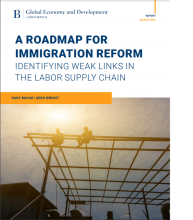A Roadmap for Immigration Reform: Identifying Weak Links in the labor Supply Chain
In this report, the authors begin by noting recent trends in the U.S. labor market—reduced labor market participation after the pandemic, and a decline in immigration resulting in labor shortages that show no sign of abating. The tight labor market has provided opportunities for many workers to shift to higher-paying jobs, exacerbating labor shortages at the low end of the labor market. In this paper, the authors analyze the labor market to identify occupations that are central to the U.S. economy; that will experience high demand over the next decade; that have traditionally been filled by immigrants; and that require little or no specialized training. Food preparation and serving occupations, construction workers, and motor vehicle operators are examples of occupations that fit the authors’ criteria. The authors also identify occupations that similarly are central to the economy and have a high percentage of foreign-born workers, but that require prior substantive training—occupations such as home health aids, nursing assistants, and other health care workers -- demand for which will be growing substantially in the coming years. The authors suggest their analysis of the labor market could be a useful tool for policymakers seeking to fill growing labor shortages. Without an increase in immigration, labor shortages in these essential occupations will worsen and, the authors argue, Americans’ standard of living will fall. (Maurice Belanger, Maurice Belanger Associates)
Bahar, D. & Wright, G. (2023, March). A Roadmap for Immigration Reform: Identifying Weak Links in the Labor Supply Chain. Brookings Institution. https://www.brookings.edu/wp-content/uploads/2023/03/Bahar-Wright-2023.pdf

